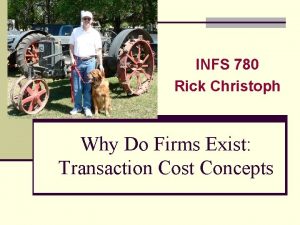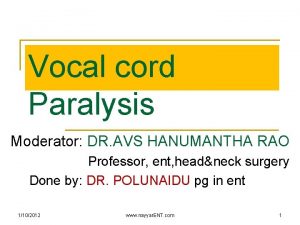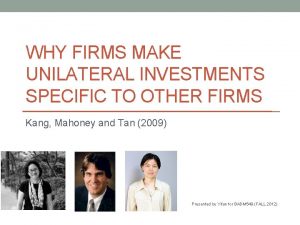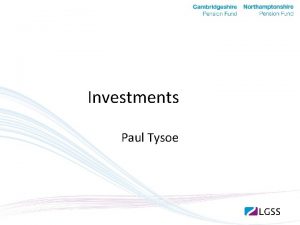WHY FIRMS MAKE UNILATERAL INVESTMENTS SPECIFIC TO OTHER









- Slides: 9

WHY FIRMS MAKE UNILATERAL INVESTMENTS SPECIFIC TO OTHER FIRMS Kang, Mahoney and Tan (2009) Presented by Yifan for BADM 549 (FALL 2012)

2 Introduction • Examines why and under what conditions firms will make unilateral relationship-specific investments to their transaction partners • Goes beyond transaction cost economics (TCE) • TCE does not consider the possibility that transactions may interdependent and have positive spillover effects (learning and capability development) • Unilateral relationship-specific investments as value-maximizing strategy (Zajac and Olson, 1993)

3 Unilateral relationship-specific investment in TCE • Contractual hazards arise from unilateral investments specific to transaction parties: • Prescription: not to take such investment unless sufficient economic safeguards have been put in place • Safeguard: secure a mutual sunk-cost commitment or mutual hostage • In practice, however, ‘powerless’ firms are willing to accept the hazards as they have no other available choices (resource-dependency theory by Pfeffer and Salancik, 1978)

4 Unilateral relationship-specific investments in OEM • Focus of interdependent transactions • Such investments are to capture potential positive economic spillovers generated from previous contracts • 2 positive spillovers: inter-project spillovers with the same transaction partner, inter-project spillovers with the other transaction partners • Taiwan OEM suppliers • The world’s largest supplier of manufacturing electronic components, PCs and devices to high-profile firms (Dell, Apple, Sony, etc. ) • Place much of the value on the positive spillovers the current transactions may yield from future transactions with the same or other OEM buyers

5 Hypotheses • H 1: The greater the economic value of inter-project knowledge spillover effects with particular client, the more likely OEM supplier will make unilateral relationship-specific investments • H 2: the greater the economic value of inter-project knowledge spillover effects with other clients, the more likely OEM suppliers will make unilateral relationship-specific investments • H 3: the greater the economic value of reputation spillover effects with other clients, the more likely OEM suppliers will make unilateral relationship-specific investments

6 Methods • Survey of 82 suppliers in IT industry (response rate 17. 5%) • Interviews of 41 suppliers in bicycle industry (41/45) • Dependent variable: relationship-specific investment • 7 indicators using Likert seven-point scale, in which 4 for tangible investment and 3 for intangible investment • Independent variables • Knowledge spillovers: multiple projects, integrated services, capability upgrading • Reputation spillovers

7 Methods

8 Results

9 Discussion • Causality • one-time data set • Which (DV or IVs) comes first? • Internal validity: single source for data on relationship- specific relationships • External validity: only a sample of Taiwan OEM suppliers • Does not examine the economic effect of the spillovers on OEM buyers
 Andreas carlsson bye bye bye
Andreas carlsson bye bye bye Chapter 11 real estate and other investments
Chapter 11 real estate and other investments Hunger games chapter 15 questions and answers
Hunger games chapter 15 questions and answers Home replication strategy example
Home replication strategy example Why do firm exist
Why do firm exist Syrup specific gravity
Syrup specific gravity Applications of specific gravity
Applications of specific gravity Dont ask
Dont ask Unilateral superior laryngeal nerve injury
Unilateral superior laryngeal nerve injury Unilateral tolerance and bilateral tolerance
Unilateral tolerance and bilateral tolerance

















